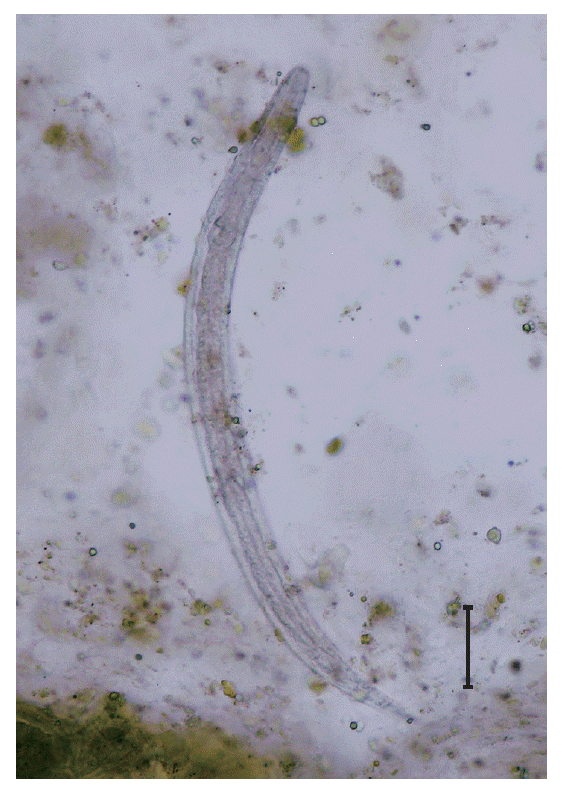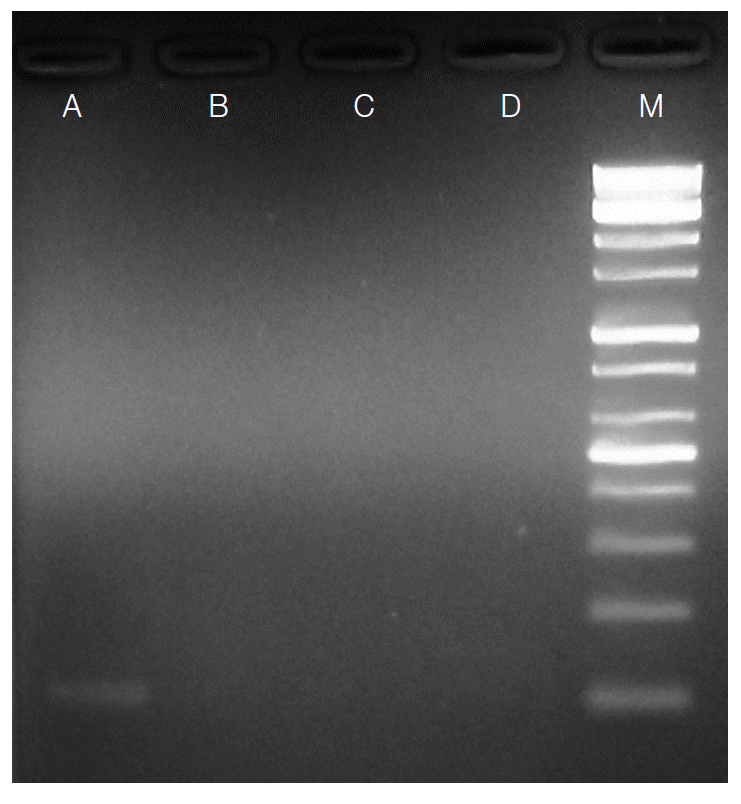INTRODUCTION
Strongyloidiasis, caused by Strongyloides stercoralis, is one of the most neglected tropical diseases and is highly under-reported in low-endemic areas [1,2]. Transmission is usually through the skin by third-stage larvae, but the nematode can also replicate within the host as an autoinfection [3]. S. stercoralis can cause a wide spectrum of diseases such as acute strongyloidiasis, chronic strongyloidiasis, hyperinfection syndrome, and disseminated infections depending on host immunity [4]. However, strongyloidiasis is frequently under-diagnosed since many infections are asymptomatic and conventional diagnostic tests based on parasitological examinations are not sufficiently sensitive [5]. Clinical suspicion is important for strongyloidiasis diagnosis. While eosinophilia is a frequently observed as initial finding in patients with strongylodiasis [6], it is also found in various other underlying conditions [7]. Moreover, unknown eosinophilia is often encountered in clinical laboratories and this hypereosinophilia syndrome (HES) can be treated with imatinib [8].
Strongyloidiasis recorded in Korea have been mainly of intestinal or hyperinfections and counted over 40 cases [9-14]. This infection is also known to be triggered by immune deficient status, e.g., lymphoma, leukemia, immunosuppressant therapy, organ transplantation, and coinfection with the human T cell lymphotropic virus type-1 [4,15-17]. Interestingly, strongyloidiasis can present as a colonic mass [18]; and thus discrimination from gastrointestinal lymphoma may be sometimes difficult. In contrast with gastrointestinal lymphoma, however, the report of strongyloidiasis with gastrointestinal stromal tumor (GIST) is limited. Here, we report a case of strongyloidiasis in a diabetic patient accompanied by gastrointestinal stromal tumor, who was initially diagnosed as hypereosinophilic syndrome (HES) and treated with steroid therapy for persistent eosinophilia uncontrolled by imatinib treatment.
CASE RECORD
A 72-year-old woman was admitted with chief complaints of lower back pain and intermittent abdominal discomfort with nausea that had lasted for 1 year. She had a medical history of type 2 diabetes mellitus and hypertension. She was transferred for a 6.5×6.5 cm mesenteric mass detected by CT at a private clinic. She underwent small bowel segmental resection and was diagnosed with GIST. During 9 months follow-up after the operation, eosinophilia persisted despite imatinib treatment. Laboratory tests revealed eosinophilia (3,760/mm3, 45.8%), anemia (hemoglobin, 11.4 g/dl), uncontrolled blood glucose (Hb A1c, 9.1%), high levels of immunoglobulin E (IgE, 326 IU/ml), and free light chain kappa (31.1 mg/dl). Serological evaluations for common parasitic infections (clonorchiasis, paragonimiasis, sparganosis, cysticercosis, and toxocariasis) were positive only for cysticercosis IgG (0.415; cut-off value, 0.234). Because there was no other evidence of cysticercosis, steroid therapy was started for HES. Although the patient received steroid therapy for 6 months, she presented with persistent eosinophilia and aggravated abdominal pain with diarrhea.
Physical examination revealed multiple erythematous patches on her buttocks; the patient also reported intermittent itching on her buttocks. Enhanced abdomino-pelvic CT showed edematous wall thickening and enhancement with moderate ascites involving the jejunum, ileum, and ascending colon. She was treated with ceftriazone and trizel for a clinical suspicion of enterocolitis. Stool examination was performed to evaluate the eosinophilia that remained uncontrolled despite the steroid therapy. The formalin-ether concentration method revealed S. stercoralis rhabditoid larvae of 320 to 325 μm in length and 15 to 18 μm in width (Fig. 1). Colonoscopy showed multiple aphthous ulcerative lesions throughout the colon, indicating chronic colitis. Eosinophilic colitis without evidence of S. stercoralis larvae was noted in a colonic biopsy. Fecal specimens were cultured using the Baermann’s funnel method; however, filariform larvae were not observed until after 72 hr in culture. Therefore, we identified S. stercoralis in stool samples by PCR using specific primers as previously described [19]. The patient was treated with 400 mg of albendazole twice a day for 14 days and her abdominal pain and diarrhea improved. S. stercoralis larvae were no longer detected in stool examination and PCR in the follow-up examinations (Fig. 2), and the eosinophilia was improved.
DISCUSSION
Clinicians often encounter eosinophilia persisting for at least 6 months without recognizable causes such as asthma, allergic disorders, or malignancies, in addition to parasitic infections. It is difficult for clinicians to investigate all possible causes of eosinophilia. In addition to eosinophilia, our patient also reported frequent nausea, abdominal discomfort, loose stool, and itching around her buttocks. The symptoms worsened with change of treatment from imatinib to steroid therapy; this might reflect an autoinfection stage by S. stercoralis. Non-response to imatinib, a treatment option for both GIST and HES [8,20], might conversely indicate that this case had a relatively low probability of clonal eosinophilia [21]. A thorough work-up for secondary eosinophilia including stool examination should have been performed at that time. Stool examination is an easy, economical, and essential tool to detect parasitic infections in clinical use, but the usefulness of stool examination has been underestimated because of its relatively low sensitivity, especially in non-endemic countries. Moreover, examination of multiple stools is imperative in clinical laboratories, considering the intermittent shedding of parasite ova in stools, but is labor-intensive. Thus, some researchers have proposed the Triple-Faeces-Test protocol for reliable detection of parasites using multiple sampling with a sodium acetate, acetic acid, and formalin fixative method or PCR [22,23].
The current case showed that molecular testing could be helpful for rapid confirmation of strongyloidiasis. While serological tests using enzyme immunoassays could be useful for diagnosing immunocompetent individuals, they are not currently available in Korea [24]. There was no pathological evidence of S. stercoralis in this case, although intestinal strongyloidiasis is typically diagnosed based on histological findings from biopsies [25]. Thus, PCR offered confirmation for the definitive diagnosis of S. stercoralis infection. There has been some debate if molecular procedures or traditional methods such as direct smear, formalin ether concentration, and various culture methods offer better detection rates, but study results vary according to the study design [5,26]. However, we believe PCR may be a sensitive and useful modality for detecting S. stercoralis in stool samples, with sensitivity comparable to formalin-ether concentrations.
We nearly missed this strongyloidiasis, and the correct diagnosis was delayed for 1 year after the onset of symptoms because of the low index of suspicion. Fortunately, the patient did not develop hyperinfection syndrome despite long-term steroid therapy. Notably, many strongyloidiasis cases have been fatal in immunocompromised patients [9,12]; thus, proper screening of potentially infected individuals is essential before administering steroid therapy. Although gastrointestinal lymphoma has been reported associated with strongyloidiasis, strongyloidiasis is scarcely reported in a patient with GIST before. This case presents strongyloidiasis triggered by steroid therapy in a diabetic patient with GIST receiving imatinib therapy and suggests the usefulness of molecular investigations to completely rule out strongyloidiasis.








